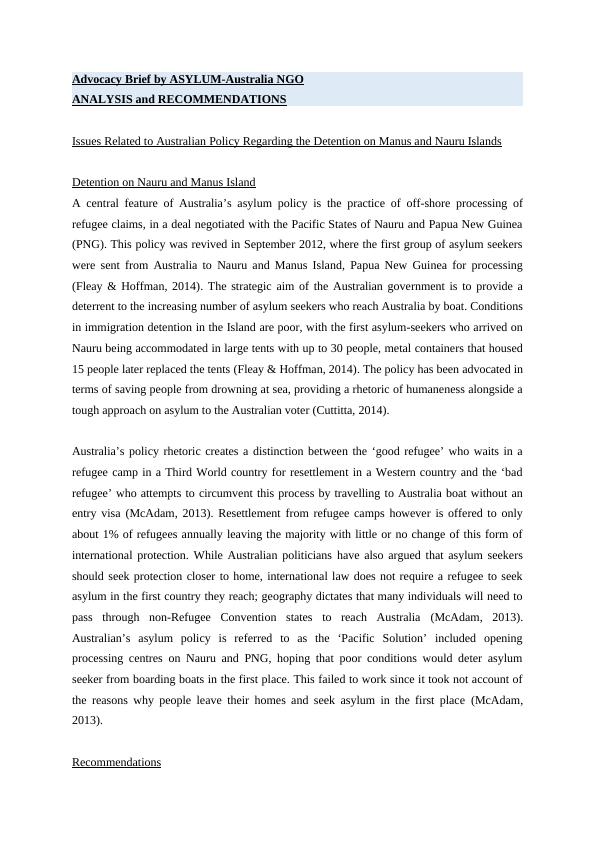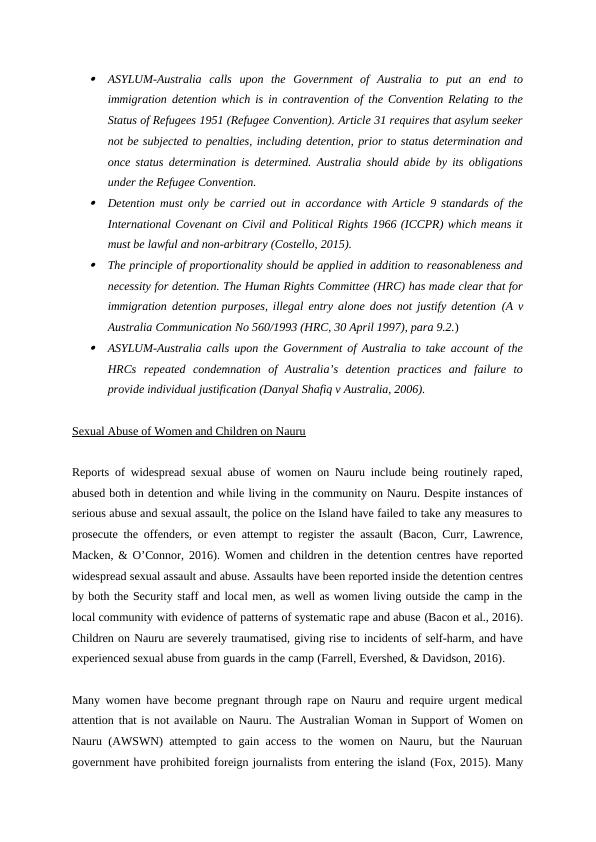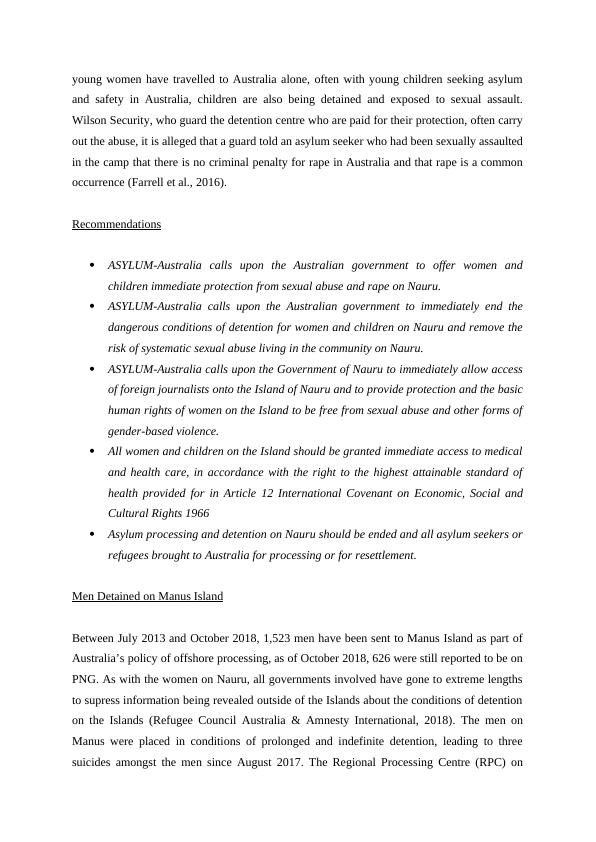Issues Related to Australian Policy Regarding the Detention on Manus and Nauru Islands
Added on 2023-04-17
6 Pages1845 Words222 Views
Advocacy Brief by ASYLUM-Australia NGO
ANALYSIS and RECOMMENDATIONS
Issues Related to Australian Policy Regarding the Detention on Manus and Nauru Islands
Detention on Nauru and Manus Island
A central feature of Australia’s asylum policy is the practice of off-shore processing of
refugee claims, in a deal negotiated with the Pacific States of Nauru and Papua New Guinea
(PNG). This policy was revived in September 2012, where the first group of asylum seekers
were sent from Australia to Nauru and Manus Island, Papua New Guinea for processing
(Fleay & Hoffman, 2014). The strategic aim of the Australian government is to provide a
deterrent to the increasing number of asylum seekers who reach Australia by boat. Conditions
in immigration detention in the Island are poor, with the first asylum-seekers who arrived on
Nauru being accommodated in large tents with up to 30 people, metal containers that housed
15 people later replaced the tents (Fleay & Hoffman, 2014). The policy has been advocated in
terms of saving people from drowning at sea, providing a rhetoric of humaneness alongside a
tough approach on asylum to the Australian voter (Cuttitta, 2014).
Australia’s policy rhetoric creates a distinction between the ‘good refugee’ who waits in a
refugee camp in a Third World country for resettlement in a Western country and the ‘bad
refugee’ who attempts to circumvent this process by travelling to Australia boat without an
entry visa (McAdam, 2013). Resettlement from refugee camps however is offered to only
about 1% of refugees annually leaving the majority with little or no change of this form of
international protection. While Australian politicians have also argued that asylum seekers
should seek protection closer to home, international law does not require a refugee to seek
asylum in the first country they reach; geography dictates that many individuals will need to
pass through non-Refugee Convention states to reach Australia (McAdam, 2013).
Australian’s asylum policy is referred to as the ‘Pacific Solution’ included opening
processing centres on Nauru and PNG, hoping that poor conditions would deter asylum
seeker from boarding boats in the first place. This failed to work since it took not account of
the reasons why people leave their homes and seek asylum in the first place (McAdam,
2013).
Recommendations
ANALYSIS and RECOMMENDATIONS
Issues Related to Australian Policy Regarding the Detention on Manus and Nauru Islands
Detention on Nauru and Manus Island
A central feature of Australia’s asylum policy is the practice of off-shore processing of
refugee claims, in a deal negotiated with the Pacific States of Nauru and Papua New Guinea
(PNG). This policy was revived in September 2012, where the first group of asylum seekers
were sent from Australia to Nauru and Manus Island, Papua New Guinea for processing
(Fleay & Hoffman, 2014). The strategic aim of the Australian government is to provide a
deterrent to the increasing number of asylum seekers who reach Australia by boat. Conditions
in immigration detention in the Island are poor, with the first asylum-seekers who arrived on
Nauru being accommodated in large tents with up to 30 people, metal containers that housed
15 people later replaced the tents (Fleay & Hoffman, 2014). The policy has been advocated in
terms of saving people from drowning at sea, providing a rhetoric of humaneness alongside a
tough approach on asylum to the Australian voter (Cuttitta, 2014).
Australia’s policy rhetoric creates a distinction between the ‘good refugee’ who waits in a
refugee camp in a Third World country for resettlement in a Western country and the ‘bad
refugee’ who attempts to circumvent this process by travelling to Australia boat without an
entry visa (McAdam, 2013). Resettlement from refugee camps however is offered to only
about 1% of refugees annually leaving the majority with little or no change of this form of
international protection. While Australian politicians have also argued that asylum seekers
should seek protection closer to home, international law does not require a refugee to seek
asylum in the first country they reach; geography dictates that many individuals will need to
pass through non-Refugee Convention states to reach Australia (McAdam, 2013).
Australian’s asylum policy is referred to as the ‘Pacific Solution’ included opening
processing centres on Nauru and PNG, hoping that poor conditions would deter asylum
seeker from boarding boats in the first place. This failed to work since it took not account of
the reasons why people leave their homes and seek asylum in the first place (McAdam,
2013).
Recommendations

ASYLUM-Australia calls upon the Government of Australia to put an end to
immigration detention which is in contravention of the Convention Relating to the
Status of Refugees 1951 (Refugee Convention). Article 31 requires that asylum seeker
not be subjected to penalties, including detention, prior to status determination and
once status determination is determined. Australia should abide by its obligations
under the Refugee Convention. Detention must only be carried out in accordance with Article 9 standards of the
International Covenant on Civil and Political Rights 1966 (ICCPR) which means it
must be lawful and non-arbitrary (Costello, 2015). The principle of proportionality should be applied in addition to reasonableness and
necessity for detention. The Human Rights Committee (HRC) has made clear that for
immigration detention purposes, illegal entry alone does not justify detention (A v
Australia Communication No 560/1993 (HRC, 30 April 1997), para 9.2.) ASYLUM-Australia calls upon the Government of Australia to take account of the
HRCs repeated condemnation of Australia’s detention practices and failure to
provide individual justification (Danyal Shafiq v Australia, 2006).
Sexual Abuse of Women and Children on Nauru
Reports of widespread sexual abuse of women on Nauru include being routinely raped,
abused both in detention and while living in the community on Nauru. Despite instances of
serious abuse and sexual assault, the police on the Island have failed to take any measures to
prosecute the offenders, or even attempt to register the assault (Bacon, Curr, Lawrence,
Macken, & O’Connor, 2016). Women and children in the detention centres have reported
widespread sexual assault and abuse. Assaults have been reported inside the detention centres
by both the Security staff and local men, as well as women living outside the camp in the
local community with evidence of patterns of systematic rape and abuse (Bacon et al., 2016).
Children on Nauru are severely traumatised, giving rise to incidents of self-harm, and have
experienced sexual abuse from guards in the camp (Farrell, Evershed, & Davidson, 2016).
Many women have become pregnant through rape on Nauru and require urgent medical
attention that is not available on Nauru. The Australian Woman in Support of Women on
Nauru (AWSWN) attempted to gain access to the women on Nauru, but the Nauruan
government have prohibited foreign journalists from entering the island (Fox, 2015). Many
immigration detention which is in contravention of the Convention Relating to the
Status of Refugees 1951 (Refugee Convention). Article 31 requires that asylum seeker
not be subjected to penalties, including detention, prior to status determination and
once status determination is determined. Australia should abide by its obligations
under the Refugee Convention. Detention must only be carried out in accordance with Article 9 standards of the
International Covenant on Civil and Political Rights 1966 (ICCPR) which means it
must be lawful and non-arbitrary (Costello, 2015). The principle of proportionality should be applied in addition to reasonableness and
necessity for detention. The Human Rights Committee (HRC) has made clear that for
immigration detention purposes, illegal entry alone does not justify detention (A v
Australia Communication No 560/1993 (HRC, 30 April 1997), para 9.2.) ASYLUM-Australia calls upon the Government of Australia to take account of the
HRCs repeated condemnation of Australia’s detention practices and failure to
provide individual justification (Danyal Shafiq v Australia, 2006).
Sexual Abuse of Women and Children on Nauru
Reports of widespread sexual abuse of women on Nauru include being routinely raped,
abused both in detention and while living in the community on Nauru. Despite instances of
serious abuse and sexual assault, the police on the Island have failed to take any measures to
prosecute the offenders, or even attempt to register the assault (Bacon, Curr, Lawrence,
Macken, & O’Connor, 2016). Women and children in the detention centres have reported
widespread sexual assault and abuse. Assaults have been reported inside the detention centres
by both the Security staff and local men, as well as women living outside the camp in the
local community with evidence of patterns of systematic rape and abuse (Bacon et al., 2016).
Children on Nauru are severely traumatised, giving rise to incidents of self-harm, and have
experienced sexual abuse from guards in the camp (Farrell, Evershed, & Davidson, 2016).
Many women have become pregnant through rape on Nauru and require urgent medical
attention that is not available on Nauru. The Australian Woman in Support of Women on
Nauru (AWSWN) attempted to gain access to the women on Nauru, but the Nauruan
government have prohibited foreign journalists from entering the island (Fox, 2015). Many

young women have travelled to Australia alone, often with young children seeking asylum
and safety in Australia, children are also being detained and exposed to sexual assault.
Wilson Security, who guard the detention centre who are paid for their protection, often carry
out the abuse, it is alleged that a guard told an asylum seeker who had been sexually assaulted
in the camp that there is no criminal penalty for rape in Australia and that rape is a common
occurrence (Farrell et al., 2016).
Recommendations
ASYLUM-Australia calls upon the Australian government to offer women and
children immediate protection from sexual abuse and rape on Nauru.
ASYLUM-Australia calls upon the Australian government to immediately end the
dangerous conditions of detention for women and children on Nauru and remove the
risk of systematic sexual abuse living in the community on Nauru.
ASYLUM-Australia calls upon the Government of Nauru to immediately allow access
of foreign journalists onto the Island of Nauru and to provide protection and the basic
human rights of women on the Island to be free from sexual abuse and other forms of
gender-based violence.
All women and children on the Island should be granted immediate access to medical
and health care, in accordance with the right to the highest attainable standard of
health provided for in Article 12 International Covenant on Economic, Social and
Cultural Rights 1966
Asylum processing and detention on Nauru should be ended and all asylum seekers or
refugees brought to Australia for processing or for resettlement.
Men Detained on Manus Island
Between July 2013 and October 2018, 1,523 men have been sent to Manus Island as part of
Australia’s policy of offshore processing, as of October 2018, 626 were still reported to be on
PNG. As with the women on Nauru, all governments involved have gone to extreme lengths
to supress information being revealed outside of the Islands about the conditions of detention
on the Islands (Refugee Council Australia & Amnesty International, 2018). The men on
Manus were placed in conditions of prolonged and indefinite detention, leading to three
suicides amongst the men since August 2017. The Regional Processing Centre (RPC) on
and safety in Australia, children are also being detained and exposed to sexual assault.
Wilson Security, who guard the detention centre who are paid for their protection, often carry
out the abuse, it is alleged that a guard told an asylum seeker who had been sexually assaulted
in the camp that there is no criminal penalty for rape in Australia and that rape is a common
occurrence (Farrell et al., 2016).
Recommendations
ASYLUM-Australia calls upon the Australian government to offer women and
children immediate protection from sexual abuse and rape on Nauru.
ASYLUM-Australia calls upon the Australian government to immediately end the
dangerous conditions of detention for women and children on Nauru and remove the
risk of systematic sexual abuse living in the community on Nauru.
ASYLUM-Australia calls upon the Government of Nauru to immediately allow access
of foreign journalists onto the Island of Nauru and to provide protection and the basic
human rights of women on the Island to be free from sexual abuse and other forms of
gender-based violence.
All women and children on the Island should be granted immediate access to medical
and health care, in accordance with the right to the highest attainable standard of
health provided for in Article 12 International Covenant on Economic, Social and
Cultural Rights 1966
Asylum processing and detention on Nauru should be ended and all asylum seekers or
refugees brought to Australia for processing or for resettlement.
Men Detained on Manus Island
Between July 2013 and October 2018, 1,523 men have been sent to Manus Island as part of
Australia’s policy of offshore processing, as of October 2018, 626 were still reported to be on
PNG. As with the women on Nauru, all governments involved have gone to extreme lengths
to supress information being revealed outside of the Islands about the conditions of detention
on the Islands (Refugee Council Australia & Amnesty International, 2018). The men on
Manus were placed in conditions of prolonged and indefinite detention, leading to three
suicides amongst the men since August 2017. The Regional Processing Centre (RPC) on

End of preview
Want to access all the pages? Upload your documents or become a member.
Related Documents
Australian Policy on Detention in Manus and Nauru Islandslg...
|7
|2037
|247
Case Study on Asylum-seekers in Australia PDFlg...
|7
|1717
|43
Advocacy brief; Australian policy regarding the detention inlg...
|6
|1610
|206
Working with Diversitylg...
|10
|2897
|216
Australia’s Offshore Immigration Policylg...
|8
|1799
|61
Immigrants and Refugees Welfare law in Australialg...
|8
|1824
|351
